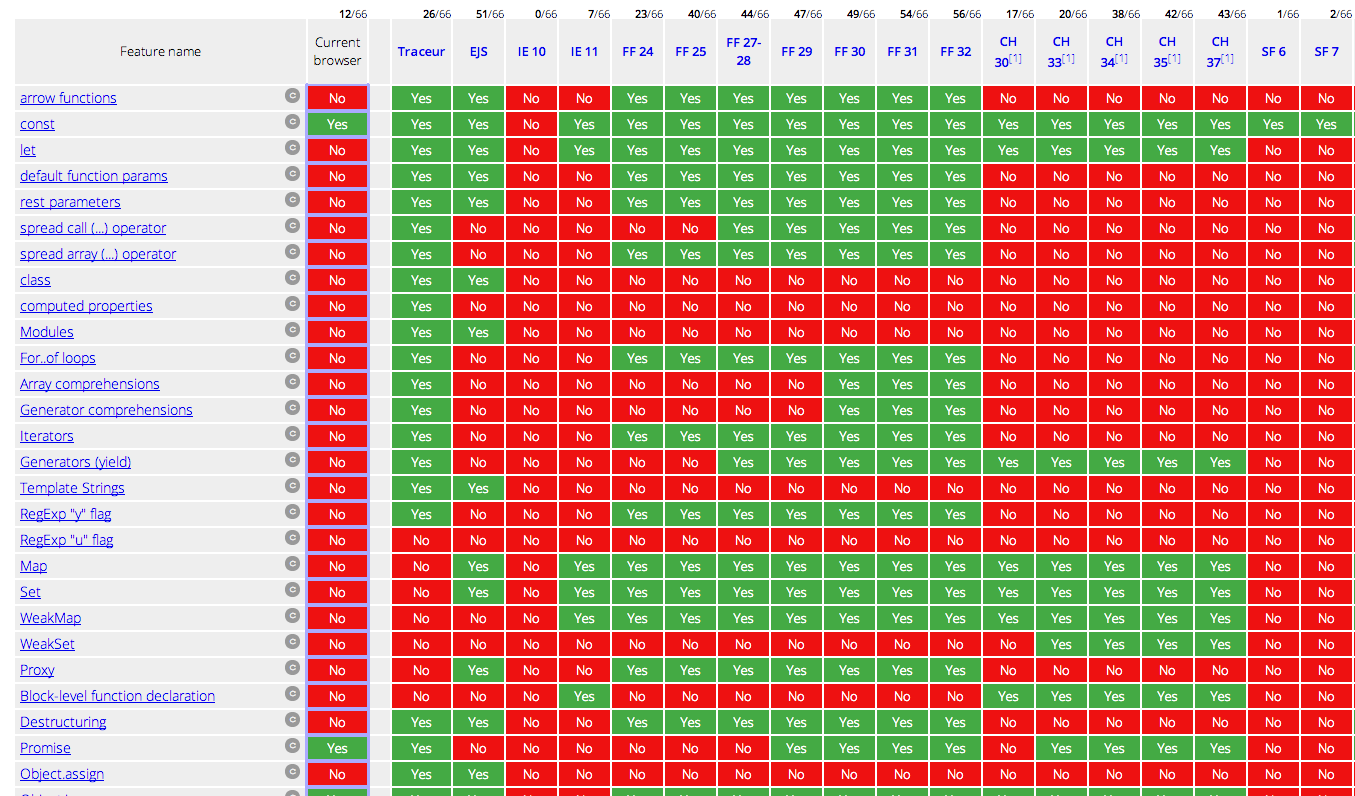Jens Ahrengot Boddum
I rely on modern technology to design and build mobile-first, highly performant WordPress websites and JavaScript-based applications.


var Animal = {
speed: 10,
init: function(el) {
this.x = 0;
el.onclick = this.move;
},
move: function() {
this.x += this.speed;
console.log("Walking...");
}
}
// Instantiate
var animal = Object.create(Animal);
animal.init( document.querySelector('.elephant') );
// Helper to force a specific context in callbacks
var __bind = function(fn, me){
return function(){
return fn.apply(me, arguments);
};
};
var Animal = {
speed: 10,
init: function(el) {
this.move = __bind(this.move, this);
this.x = 0;
el.onclick = this.move;
},
move: function() {
this.x += this.speed;
console.log("Walking...");
}
}
// Instantiate
var animal = Object.create(Animal);
animal.init( document.querySelector('.elephant') );
var Animal = function(el) { this.move = __bind(this.move, this); this.x = 0; el.onclick = this.move; } Animal.prototype.speed = 10;Animal.prototype.move = function() { this.x += this.speed; console.log("Walking..."); } // Instantiate var animal = new Animal( document.querySelector('.elephant') );
function Class() {
var initializing = false, fnTest = /xyz/.test(function(){xyz;}) ? /\b_super\b/ : /.*/;
// The base Class implementation (does nothing)
this.Class = function(){};
// Create a new Class that inherits from this class
Class.extend = function(prop) {
var _super = this.prototype;
// Instantiate a base class (but only create the instance,
// don't run the init constructor)
initializing = true;
var prototype = new this();
initializing = false;
// Copy the properties over onto the new prototype
for (var name in prop) {
// Check if we're overwriting an existing function
prototype[name] = typeof prop[name] == "function" &&
typeof _super[name] == "function" && fnTest.test(prop[name]) ?
(function(name, fn){
return function() {
var tmp = this._super;
// Add a new ._super() method that is the same method
// but on the super-class
this._super = _super[name];
// The method only need to be bound temporarily, so we
// remove it when we're done executing
var ret = fn.apply(this, arguments);
this._super = tmp;
return ret;
};
})(name, prop[name]) :
prop[name];
}
// The dummy class constructor
function Class() {
// All construction is actually done in the init method
if ( !initializing && this.init )
this.init.apply(this, arguments);
}
// Populate our constructed prototype object
Class.prototype = prototype;
// Enforce the constructor to be what we expect
Class.prototype.constructor = Class;
// And make this class extendable
Class.extend = arguments.callee;
return Class;
};
}
// Animal class
var Animal = Class.extend({
speed: 10,
init: function(el){
this.x = 0;
this.move = __bind(this.move, this);
el.onclick = this.move;
},
move: function(){
this.x += this.speed;
console.log("Walking...");
}
});
// Extend base class
var Tiger = Animal.extend({
speed: 50
});
//Instantiate
var tony = new Tiger( document.querySelector('.tony-the-tiger') );
// Define Animal class
class Animal {
constructor(el) {
this.x = 0;
el.onclick = this.move;
}
move() {
this.x += this.speed;
console.log("Walking...")
}
public speed = 10;
}
// Extend animal class
class Tiger extends Animal {
public speed = 50;
}
// Instantiate
var tony = new Tiger( document.querySelector('.tony-the-tiger') );


# Helper to force a specific context in callbacks
__bind = (fn, me) ->
return () ->
return fn.apply(me, arguments);
# Define Animal class
class Animal
speed: 10,
constructor: (el) ->
this.x = 0;
el.onclick = this.move;
move: () ->
this.x += this.speed;
console.log("Walking...");
# Extend Animal class
class Tiger extends Animal
speed: 50
# Instantiate
tony = new Tiger( document.querySelector( '.tony-the-tiger' ) );
# Define Animal class
class Animal
speed: 10
constructor: (el) ->
@x = 0
el.onclick = @move
move: =>
@x += @speed
console.log "Walking..."
# Extend Animal class
class Tiger extends Animal
speed: 50
# Instantiate
tony = new Tiger document.querySelector '.tony-the-tiger' var Animal, Tiger, tony,
__hasProp = {}.hasOwnProperty,
__extends = function(child, parent) { for (var key in parent) { if (__hasProp.call(parent, key)) child[key] = parent[key]; } function ctor() { this.constructor = child; } ctor.prototype = parent.prototype; child.prototype = new ctor(); child.__super__ = parent.prototype; return child; };
Animal = (function() {
Animal.prototype.speed = 10;
function Animal(el) {
this.x = 0;
el.onclick = this.move;
}
Animal.prototype.move = function() {
this.x += this.speed;
return console.log("Walking...");
};
return Animal;
})();
Tiger = (function(_super) {
__extends(Tiger, _super);
function Tiger() {
return Tiger.__super__.constructor.apply(this, arguments);
}
Tiger.prototype.speed = 50;
return Tiger;
})(Animal);
tony = new Tiger(document.querySelector('.tony-the-tiger')); someObject = {
dynamicContext: ->
# 'This' changes
controlledContext: =>
# 'This' is always someObject
}foods = ['broccoli', 'spinach', 'chocolate']
eat food for food in foods when food isnt 'chocolate'
var foods, food, _i, _len;
foods = ['broccoli', 'spinach', 'chocolate'];
for (_i = 0, _len = foods.length; _i < _len; _i++) {
food = foods[_i];
if (food !== 'chocolate') {
eat(food);
}
}
[10..1]
# => [10, 9, 8, 7, 6, 5, 4, 3, 2, 1]numbers = [5,7,3]
min = Math.min numbers...
# => var min = Math.min(5, 7, 3);By Jens Ahrengot Boddum
(Danish) A short walkthrough of the little language that reimagines JavaScript
I rely on modern technology to design and build mobile-first, highly performant WordPress websites and JavaScript-based applications.